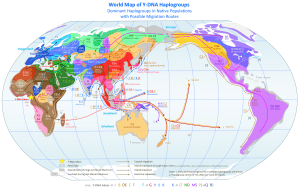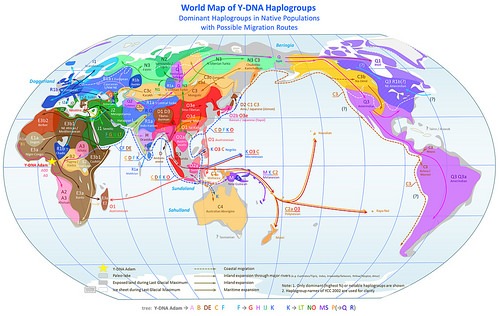
WELLCOME TRUST SANGER INSTITUTE—The largest ever study* of global genetic variation in the human Y chromosome has uncovered the hidden history of men. Research published in Nature Genetics reveals explosions in male population numbers in five continents, occurring at times between 55 thousand and four thousand years ago.
The study, led by Dr Chris Tyler-Smith of the Wellcome Trust Sanger Institute, analysed sequence differences between the Y chromosomes of more than 1200 men from 26 populations around the world using data generated by the 1000 Genomes Project.
The work involved 42 scientists from four continents.
Dr David Poznik, from Stanford University, California, first author on the paper, said: “We identified more than 60,000 positions where one DNA letter was replaced by another in a man with modern descendants, and we discovered thousands of more complex DNA variants. These data constitute a rich and publicly available resource for further genealogical, historical and forensic studies.”
Analysing the Y chromosomes of modern men can tell us about the lives of our ancestors. The Y chromosome is only passed from father to son and so is wholly linked to male characteristics and behaviours. The team used the data to build a tree of these 1200 Y chromosomes; it shows how they are all related to one another. As expected, they all descend from a single man who lived approximately 190,000 years ago.
The most intriguing and novel finding was that some parts of the tree were more like a bush than a tree, with many branches originating at the same point.
Dr Yali Xue, lead author from the Wellcome Trust Sanger Institute, explained: “This pattern tells us that there was an explosive increase in the number of men carrying a certain type of Y chromosome, within just a few generations. We only observed this phenomenon in males, and only in a few groups of men.”
The earliest explosive increases of male numbers occurred 50,000-55,000 years ago, across Asia and Europe, and 15,000 years ago in the Americas. There were also later expansions in sub-Saharan Africa, Western Europe, South Asia and East Asia, at times between 4,000 and 8,000 years ago. The team believes the earlier population increases resulted from the first peopling by modern humans of vast continents, where plenty of resources were available.
_______________________________________
Chakazul, Wikimedia Commons
____________________________________________________
The later expansions are more enigmatic.
Dr Chris Tyler-Smith, from the Sanger Institute, added: “The best explanation is that they may have resulted from advances in technology that could be controlled by small groups of men. Wheeled transport, metal working and organised warfare are all candidate explanations that can now be investigated further.”
All of the samples and data from the 1000 Genomes Project are freely available for use by other scientists and interested investigators.
Source: Wellcome Trust Sanger Institute
_____________________________________________________
*Poznik GD et al. Punctuated bursts in human male demography inferred from 1,244 worldwide Y-chromosome sequences is published in Nature Genetics 25 April 2016 DOI: 10.1038/ng.3559
_____________________________________________________

______________________________________________
Travel and learn with Far Horizons.
____________________________________________
This richly illustrated issue includes the following stories: Recent findings shedding new light on the whereabouts of the remains of Philip of Macedon, father of Alexander the Great; how an archaeologist-sculptor is bringing bones of the dead back to life; archaeologists uncovering town life at the dawn of civilization; an exclusive interview with internationally acclaimed archaeologist James M. Adovasio about what makes the Meadowcroft Rockshelter prominent in the ongoing search for the first Americans; what archaeologists are finding at the site of the ancient city of Gath, the home town of the biblical Philistine giant, Goliath; and how scientists are redrawing the picture of human evolution in Europe. Find it on Amazon.com.








